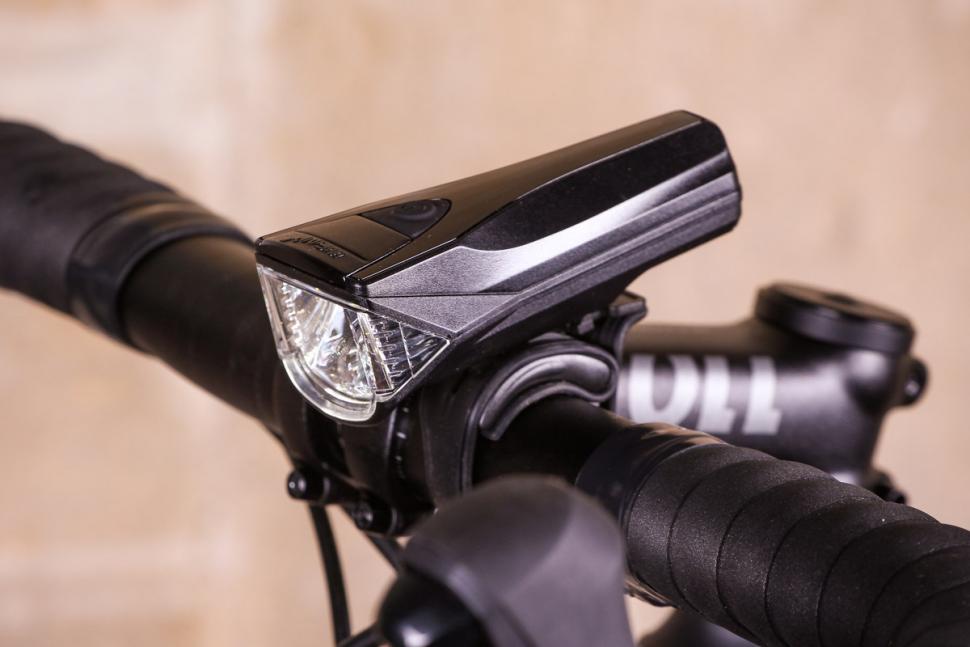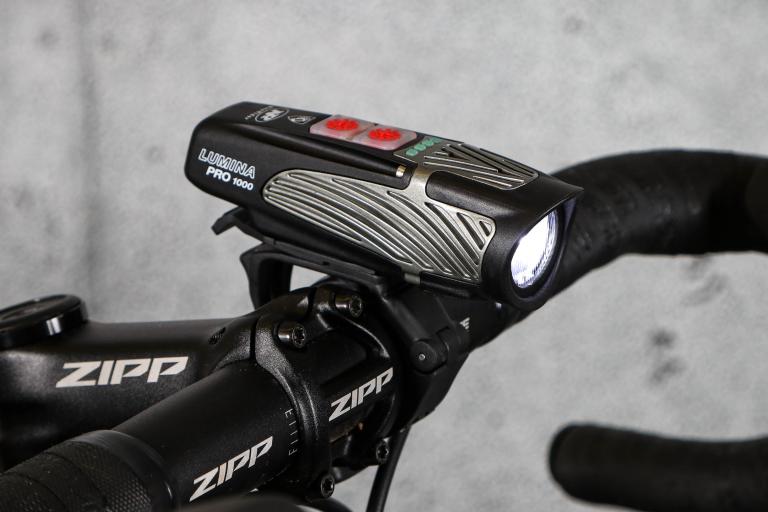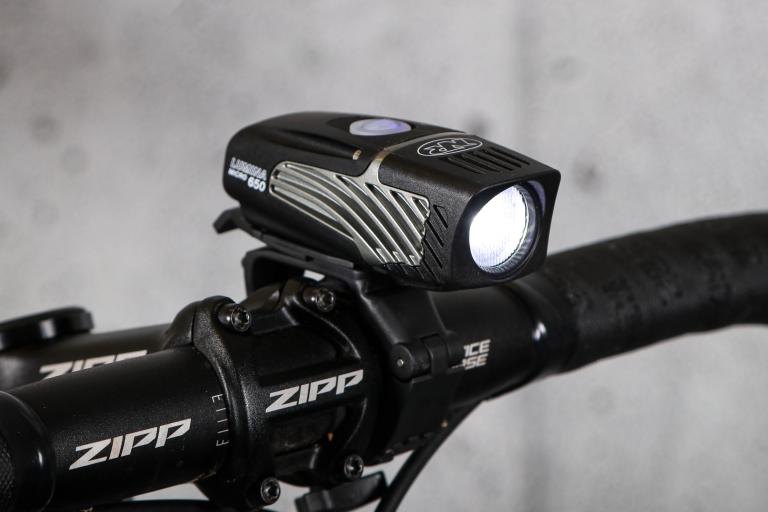- News
- Reviews
- Bikes
- Accessories
- Accessories - misc
- Computer mounts
- Bags
- Bar ends
- Bike bags & cases
- Bottle cages
- Bottles
- Cameras
- Car racks
- Child seats
- Computers
- Glasses
- GPS units
- Helmets
- Lights - front
- Lights - rear
- Lights - sets
- Locks
- Mirrors
- Mudguards
- Racks
- Pumps & CO2 inflators
- Puncture kits
- Reflectives
- Smart watches
- Stands and racks
- Trailers
- Clothing
- Components
- Bar tape & grips
- Bottom brackets
- Brake & gear cables
- Brake & STI levers
- Brake pads & spares
- Brakes
- Cassettes & freewheels
- Chains
- Chainsets & chainrings
- Derailleurs - front
- Derailleurs - rear
- Forks
- Gear levers & shifters
- Groupsets
- Handlebars & extensions
- Headsets
- Hubs
- Inner tubes
- Pedals
- Quick releases & skewers
- Saddles
- Seatposts
- Stems
- Wheels
- Tyres
- Health, fitness and nutrition
- Tools and workshop
- Miscellaneous
- Buyers Guides
- Features
- Forum
- Recommends
- Podcast
review
 Infini Saturn 300 front light
Infini Saturn 300 front light£34.99
VERDICT:
Effective and 'considerate' beam is excellent, but it's let down by a hard-to-operate switch
Weight:
105g
Contact:
At road.cc every product is thoroughly tested for as long as it takes to get a proper insight into how well it works. Our reviewers are experienced cyclists that we trust to be objective. While we strive to ensure that opinions expressed are backed up by facts, reviews are by their nature an informed opinion, not a definitive verdict. We don't intentionally try to break anything (except locks) but we do try to look for weak points in any design. The overall score is not just an average of the other scores: it reflects both a product's function and value – with value determined by how a product compares with items of similar spec, quality, and price.
What the road.cc scores meanGood scores are more common than bad, because fortunately good products are more common than bad.
- Exceptional
- Excellent
- Very Good
- Good
- Quite good
- Average
- Not so good
- Poor
- Bad
- Appalling
The Infini Saturn 300 provides a bright beam with decent run-times and a good battery capacity indication system. Although it has a very welcome 'no dazzle' beam design, the difficult-to-operate switch and a slightly unstable mount detract from what is an otherwise very good unit.
- Pros: Decent beam that won't dazzle oncoming traffic, good battery indicator
- Cons: Tough to turn on, narrow beam takes some getting used to
The main polycarbonate case of the Saturn 300 is designed for both front and lateral visibility. A specially shaped lens cuts off the frontal beam's visibility in a line ahead of the rider, meaning that anyone facing the light will not get dazzled. These kind of lenses are obligatory in Germany, and it's great to see Infini bringing them to the UK market.
> Find your nearest dealer here
Despite the case not feeling the sturdiest, it stood up to several 1m drop tests. Similarly, although it 'only' has a waterproof rating of IPX4, meaning it should 'resist water splashes from any direction', it stood up to storm Diana and handled a five-minute power shower too.
The lithium-ion battery recharges in a claimed 3 hours via a (rather short) supplied Micro-USB cable. The switch glows green when the battery capacity is 100-50%, amber for 49-25% and red for below 25%.
Modes and output
The Saturn has five modes: Constant, Boost, Super Bright, Pulsating and Flashing.
Its maximum output of 300 lumens in Super Bright gives out a strong beam that's good enough to light the way on an unlit road at steady speeds (less than 17mph). It took me a while to get used to the concentrated beam that the Saturn gives off. If you look at it on the comparison engine against, for example, the recently tested Blackburn Dayblazer 400, you can see what I mean. I frequently found myself making micro adjustments to the Saturn's position to light up what I knew were my daily pothole encounters. There is certainly an optimum position for the light.
With that narrow beam, peripheral lighting isn't great; the Saturn is a no-no for riding towpaths, gravel tracks or unfamiliar lanes. Because the beam is concentrated in a line it's plenty bright, just not over the area that you might be used to.
It got me seen on straight roads by oncoming traffic at around 200m, which isn't bad for a 'cheaper light'. I have been consistently getting over the claimed 3 hours out of this mode, too.
> Buyer's Guide: The best front lights for cycling
Boost mode offers sufficient light to navigate semi-lit roads. It's not a massive drop down from the Super Bright in terms of seeing or being seen. It's perfect for use in semi-lit areas. It also runs for over the claimed 6 hours in this mode.
The lowest constant mode is for being seen rather than seeing with; it isn't bright enough to ride confidently at a decent pace on unlit roads, it's more a 'knock-about-town' mode. This was the only mode that failed to last the claimed time – I got 17 hours from it, an hour off the claimed 18.
The pulsating mode is great. It's striking, and casts a continual background light that is quite strong, easily seen from about 25m. It's great in urban areas. The biggest bonus about this and the flashing mode is their run-times. I was getting 43 hours out of the pulsating (claimed 40) and 351 (claimed 350) out of the flashing. The flashing mode is not amazing: it will get you seen, but not from a distance of more than about 15m.
In short, I relied heavily on the Super Bright mode. With only a 30-minute commute, I wasn't having to charge it excessively and, even better, I was happy that I wasn't blinding any other road users, so I was able to complete my mix of rural and urban commute without switching modes.
Switch/indicator
If the beam took some getting used to, I struggled beyond measure with the switch. Sorry Infini, but while the rubber-coated button might be deemed 'tactile' by some, I didn't find it easy to operate with gloves on. It needs a long press (1.5 seconds, though it felt longer) to switch it on and off, and a single press to cycle through the modes. It is very stiff and the only way I could locate it easily and sense the necessary click that activates the light was by going without gloves. A real let-down on an otherwise very good light.
The battery indicator I mentioned above is clear and accurate, and in case these indicators aren't enough, when it hits 25% remaining, the LED will begin to intermittently flash if it is in a constant mode, and begin to cycle with a prolonged phase if it's in flashing mode. This is useful if you choose to mount the light on your helmet (possible but not ideal), or you're colour blind.
Mount
The mount is a simple silicone strip that wraps round a bracket. It is tool-free and idiot-proof, so easy to move from bike to bike. I found that I needed to over-tighten the strap in order to eliminate vibrations that caused significant movement and consequently a 'wobbly beam', exacerbated by how concentrated it is. Even with the strap at its tightest point there was still a small amount of beam-wobble on rough roads. It's the compromise of a bracket that has play to allow for its rotational feature.
As I mentioned, I frequently made use of the rotating bracket to get an optimum position. It swings out of the way easily to mount other devices and I also found myself turning it 180 degrees to provide light for my pannier packing at night.
Although the whole thing looks and feels quite cheap, it functions perfectly well and the lever mechanism is surprisingly secure. I've had it on a variety of bars and the strap has plenty of positions for any width.
The light also slides off the bracket easily if you depress a small lever.
Value
Price-wise it's not hugely expensive compared with others out there: it's £1 less than Kryptonite's Street F-300, and £1 more than Blackburn's DayBlazer 400, which offers better peripheral lighting and a better switch.
Conclusion
It might take some getting used to the beam, but the Saturn 300 isn't a bad choice if your regular commute means navigating urban areas as well as unlit roads. It packs a punch, it's just a shame about the difficult-to-operate switch.
Verdict
Effective and 'considerate' beam is excellent, but it's let down by a hard-to-operate switch
road.cc test report
Make and model: Infini Saturn 300 front light
Size tested: n/a
Tell us what the light is for, and who it's aimed at. What do the manufacturers say about it? How does that compare to your own feelings about it?
Infini says, "Often being seen is as important as seeing the road ahead. The SATURN 300 I-330P bicycle headlight achieves just that by projecting a safe, clear and long running 300 lumens of output. Additionally, the beam of the SATURN 300 has been tuned to truncate in a precise line in front of the rider to maximize visibility while minimizing any blinding of an observer. The result is a light that is safer and more efficient than standard lights in this category. USB rechargeable and with 5 modes of operation, the SATURN 300 is an ideal balance between safety, efficiency and performance.
'The SATURN 300 I-330P is housed in a polycarbonate main case designed for both front and lateral visibility. A specially shaped lens cuts off the frontal beam's visibility in a line ahead of the rider to be as safe for viewers as it is for the rider. Rubber coated buttons are tactile and can easily be operated with gloved fingers while the battery indicators are intuitive and informative.'
Tell us some more about the technical aspects of the light?
SIZE 103x42x38.5 mm
WEIGHT 88g (excluding bracket)
LED Hi-Power 3 Watt White LED
BRIGHTNESS 300 Lumens
BATTERY Rechargeable Lithium-ion Battery
RUN TIME 18hrs (Constant) / 6hrs (Boost) / 3hrs (Super Bright) / 40hrs (Pulsating) / 70hrs (Flashing)
CHARGE 3hrs (DC/5V, 1A)
STANDARD German
BRACKET HB11, fit Ø19-Ø38 mm
Rate the light for quality of construction:
8/10
Feels pretty cheap but it's stood up to several 1m drop tests and a power shower.
Rate the light for design and ease of use. How simple was the light to use?
4/10
Very hard to switch on and off. The button needs to be pressed for 1.5 seconds to turn it on/off and it's stiff. Also, although the button looks substantial in terms of size, it actually only responds if you press it at a particular point. All very awkward in a decent winter glove.
Rate the light for the design and usability of the clamping system/s
6/10
Quick and easy to switch between bikes but needs to be overtightened to be effective.
Rate the light for waterproofing. How did it stand up to the elements?
9/10
Stood up well to Storm Diana! It's only rated IPX4 but this has proved good enough.
Rate the light for battery life. How long did it last? How long did it take to recharge?
8/10
All run-times were somewhat over the claimed ones except the low constant, which was a claimed 18 hours and I only got 17 out of it. Charge time was 3 hours as claimed.
Rate the light for performance:
8/10
Pretty powerful but a narrower beam than I'm used to. It's good to know that the light isn't blinding other riders or drivers.
Rate the light for durability:
8/10
Survived being dropped unscathed.
Rate the light for weight:
8/10
Rate the light for value:
6/10
It's not overly expensive for a light that packs quite a punch, but the switch detracts somewhat.
Tell us how the light performed overall when used for its designed purpose
It definitely gets you seen and is strong enough to see with.
Tell us what you particularly liked about the light
Powerful beam from a light that won't break the bank and won't blind others.
Tell us what you particularly disliked about the light
The switch!
How does the price compare to that of similar products in the market, including ones recently tested on road.cc?
Kryptonite's Street F-300 front light is £1 more, while the Blackburn DayBlazer 400 is £1 less, and for 1p more you could have the Niterider Swift 500. It's nearly a tenth of the price of the Exposure Strada SB...
Did you enjoy using the light? Once I'd got it on, yes.
Would you consider buying the light? No, sadly not.
Would you recommend the light to a friend? If they rarely wear gloves, maybe!
Use this box to explain your overall score
Great beam technology, but a shame it's been combined with a poorly designed switch. I really the light itself but this switch needs sorting out.
About the tester
Age: 39
I usually ride: Road My best bike is: Carbon road
I've been riding for: Over 20 years I ride: Most days I would class myself as: Expert
I regularly do the following types of riding: commuting, touring, club rides, general fitness riding, getting to grips with off-roading too!
Emma’s first encounters with a road bike were in between swimming and running. Soon after competing for GB in the World Age Group Triathlon Championships in Edmonton in 2001 she saw the light and decided to focus on cycling.
After a couple of half decent UK road seasons racing for Leisure Lakes, she went out to Belgium to sample the racing there and spent two years with Lotto-Belisol Ladies team, racing alongside the likes of Sara Carrigan, Grace Verbeke, Rochelle Gilmore and Lizzie Deignan. Emma moved from Lotto-Belisol to Dutch team Redsun, then a new Belgian team of primarily developing riders, where there was less pressure, an opportunity to share her experience and help build a whole new team; a nice way to spend her final years of professional racing.
Since retiring Emma has returned to teaching. When not coercing kids to do maths, she is invariably out on two wheels. In addition to the daily commute, Emma still enjoys getting out on her road bike and having her legs ripped off on the local club rides and chain gangs. She has also developed an addiction to touring, with destinations including Iceland, Georgia and Albania, to mention just a few. There have also been rare sightings of Emma off-road on a mountain bike…
Latest Comments
- ktache 2 hours 37 min ago
The small frame, the aggressive posture, lots of standover height.
- mctrials23 3 hours 32 min ago
As i've said before, the police should be sued for a lot of money when someone they have knowingly ignored has gone on to commit a serious crime....
- David9694 3 hours 40 min ago
'Bad parking' blocks firefighters multiple times on same emergency call-out...
- David9694 3 hours 44 min ago
Cambridgeshire boy, 13, crashes Audi into garden wall after taking it from home...
- Adam Sutton 4 hours 30 min ago
Good stuff. Now do it on cycleway C9 through Hammersmith to Chiswick.
- mark1a 4 hours 39 min ago
It's technically allowed but it's not known as "London's Orbital Car Park" for nothing.
- Dogless 5 hours 47 min ago
You're defending bombing hospitals and refugee camps and starving children.
- mattw 8 hours 27 min ago
Used car salesman is a complete attention-seeking plank....
- tubasti 8 hours 44 min ago
I don't know if they're any better, but they's certainly become more boring.
- FionaJJ 9 hours 10 min ago
At risk of being cynical, and stereotyping the police, it's so they don't have to leave the comfort of their panda cars and pursue on foot when...




Add new comment
2 comments
Much better. These are the kinds of lights you should be reviewing. A website called "ROAD" should only review lights that are suitable for the road. The 3 million lumen torches that most people ride with are not suitable for the road.
I feel that most people are largely ignorant of the benefits of lights with a beam cutoff, thinking they can somehow duplicate the effect by "pointing it down a bit". You can't. If it dazzles when pointing straight ahead, it'll dazzle when pointing down too. It's basic optics.
Thank you for taking the time to do a very thorough review of light suitable for those who are considerate of other road users. It doesn't look as good optically as the old Philips Saferides, which combined a cut-off with a much wider beam, but better than Cateye's StVZO range, and with similarly improved battery life.